Orthorhombically Packed Cosmetic Oils or Formulations Could Ensure Skin Lipid Barrier Stability—An Ex Vivo Porcine Skin Study
Abstract
1. Introduction
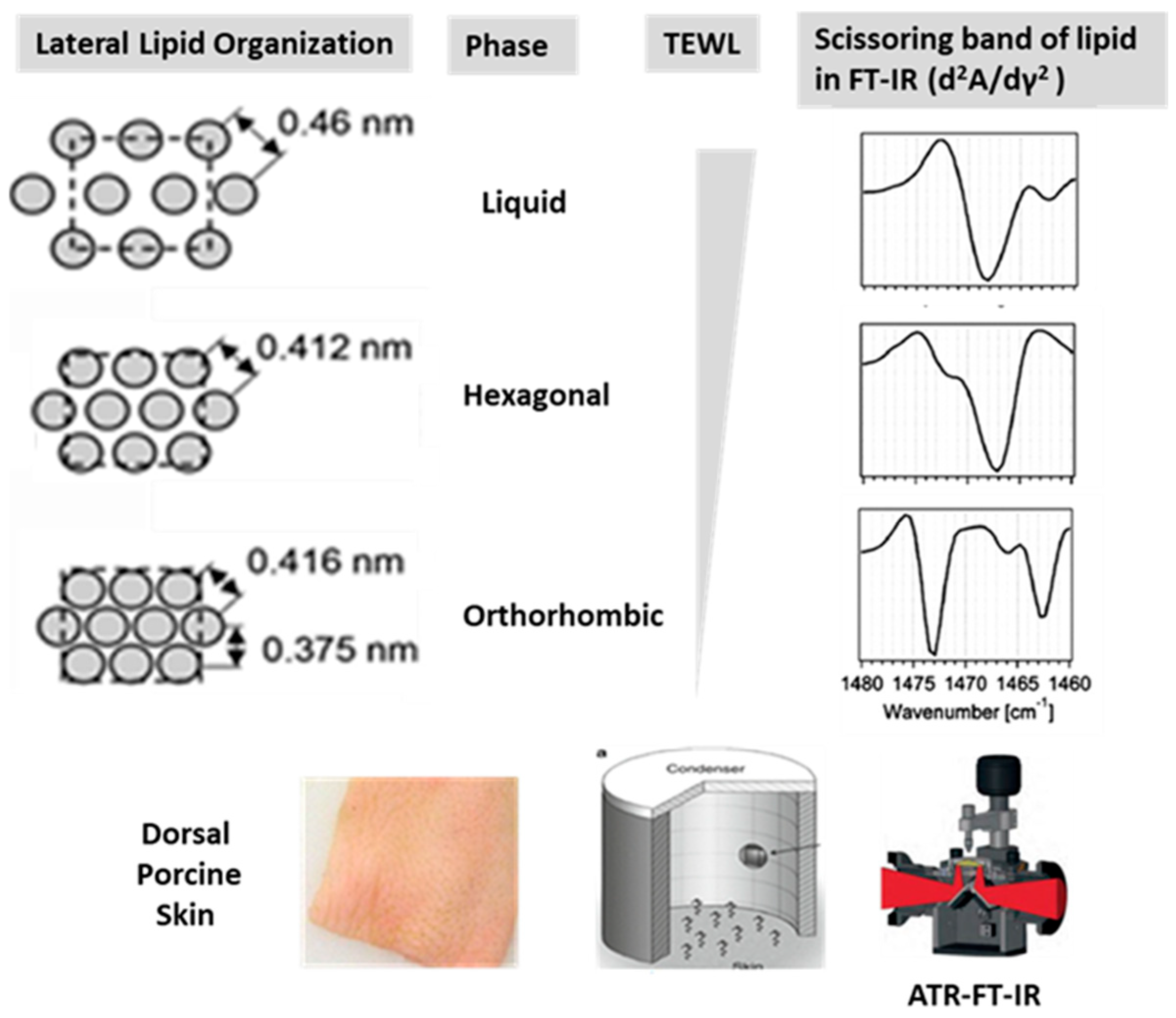
2. Materials and Methods
2.1. Materials
- INCI name: Squalane. Emollient
- Liquid. It is a branched hydrocarbon with the raw formula C30H62. It is a hydrogenated version of fish squalene (Kishimoto, Osaka, Japan)
- INCI name: Paraffinum Liquidum, Emollient
- Liquid, Mixture of hydrocarbons (typically ranging from C15 to C40, obtained from petroleum (Michang, Ulsan, Republic of Korea)
- INCI name: Isononyl Isononanoate. Emollient
- Liquid. It is a branched hydrocarbon with the raw formula C30H62. It is a hydrogenated version of fish squalene (BASF, Ludwigshafen, Germany)
- INCI name: Isopropyl myristate. Emollient
- Liquid. Isopropyl myristate is a liquid ester synthesized from isopropyl alcohol and myristic acid (C17H34O2). The ester formed from isopropyl alcohol and myristic acid (Acid Chem, Penang, Malaysia)
- INCI name: Paraffin wax. Viscosity controlling
- A solid mixture of hydrocarbons (C51–59), produced by catalytic conversion of low-molecular-weight gaseous hydrocarbons. Melting point 70 °C (MDS, Bintulu, Sarawak, Malaysia),
- INCI: Beeswax, Viscosity controlling
- A solid consist esters of free fatty acid (C24–C30) and various long-chain alcohol (C24–C36) (Dain, Seoul, Republic of Korea),
- INCI: Ceramide NP
- Solid, Ceramide 3B is composed of a saturated sphingosine base with 14 carbon atoms, conjugated via an amide bond to oleic acid, which contains one double bond (Doosan, Seoul, Republic of Korea)
- INCI: Cetearyl Alcohol and Cetearyl Glucoside
- Solid, Montanov 68 is a nonionic emulsifier composed of fatty alcohol (Cetearyl Alcohol) and glucose derivative (Cetearyl Glucoside), providing stable oil-in-water emulsification (Seppic, La Garenne-Colombes, France).
2.2. Preparation of the Emulsion for Structural Analysis
2.3. Sample Treatment for Analyzing the Impact on Skin Barrier
2.4. ATR-FT-IR Measurement
2.5. IR Data Analysis
2.6. Statistical Processing
3. Results
3.1. ATR-FT-IR Analysis of Molecular Packing in Skin Barrier Lipids
3.2. Analysis of Skin Barrier Function and Lipid Packing Structure in Porcine Skin Following SDS Treatment
3.3. Analysis of Lipid Packing Structure in Cosmetic Oils
3.4. Impact of Oil Packing Structures on Skin Barrier Function
3.5. Formulation of Products Exhibiting Orthorhombic and Hexagonal Lipid Packing Structures
3.6. Effects of Emulsion Formulations on Skin Barrier Function: A Comparative Analysis of Orthorhombic and Hexagonal Lipid Packing Structures
4. Discussion
Author Contributions
Funding
Data Availability Statement
Conflicts of Interest
References
- Bouwstra, J.A.; Ponec, M. The Skin Barrier in Healthy and Diseased State. Biochim. Biophys. Acta Biomembr. 2006, 1758, 2080–2095. [Google Scholar] [CrossRef]
- Coderch, L.; Lopez, O.; de la Maza, A.; Parra, J.L. Ceramides and Skin Function. Am. J. Clin. Dermatol. 2003, 4, 107–129. [Google Scholar] [CrossRef]
- Vietri Rudan, M.; Watt, F.M. Mammalian Epidermis: A Compendium of Lipid Functionality. Front. Physiol. 2022, 12, 804824. [Google Scholar] [CrossRef]
- Damien, F.; Boncheva, M. The Extent of Orthorhombic Lipid Phases in the Stratum Corneum Determines the Barrier Efficiency of Human Skin In Vivo. J. Investig. Dermatol. 2010, 130, 611–614. [Google Scholar] [CrossRef] [PubMed]
- Alsamad, F.; Stamatas, G.N. Directional Assessment of the Skin Barrier Function in Vivo. Skin Res. Technol. 2023, 29, e13346. [Google Scholar] [CrossRef] [PubMed]
- Pensack, R.D.; Michniak, B.B.; Moore, D.J.; Mendelsohn, R. Infrared Kinetic/Structural Studies of Barrier Reformation in Intact Stratum Corneum Following Thermal Perturbation. Appl. Spectrosc. 2006, 60, 1399–1404. [Google Scholar] [CrossRef]
- Lee, S.H.; Jun, S.H.; Yeom, J.; Park, S.G.; Lee, C.K.; Kang, N.G. Optical Clearing Agent Reduces Scattering of Light by the Stratum Corneum and Modulates the Physical Properties of Coenocytes via Hydration. Skin Res. Technol. 2018, 24, 371–378. [Google Scholar] [CrossRef] [PubMed]
- Yarovoy, Y.; Drutis, D.M.; Hancewicz, T.M.; Garczarek, U.; Ananthapadmanabhan, K.P.; Misra, M. Quantification of Lipid Phase Order of In Vivo Human Skin Using Attenuated Total Reflection Fourier Transform Infrared (ATR FT-IR) Spectroscopy and Multivariate Curve Resolution Analysis. Appl. Spectrosc. 2019, 73, 182–194. [Google Scholar] [CrossRef]
- Bouwstra, J.A.; Nădăban, A.; Bras, W.; McCabe, C.; Bunge, A.; Gooris, G.S. The Skin Barrier: An Extraordinary Interface with an Exceptional Lipid Organization. Prog. Lipid Res. 2023, 92, 101252. [Google Scholar] [CrossRef]
- Boncheva, M.; Damien, F.; Normand, V. Molecular Organization of the Lipid Matrix in Intact Stratum Corneum Using ATR-FTIR Spectroscopy. Biochim. Biophys. Acta Biomembr. 2008, 1778, 1344–1355. [Google Scholar] [CrossRef]
- Bouwstra, J.A.; Gooris, G.S.; Dubbelaar, F.E.R.; Ponec, M. Phase Behavior of Stratum Corneum Lipid Mixtures Based on Human Ceramides: The Role of Natural and Synthetic Ceramide 1. J. Investig. Dermatol. 2002, 118, 606–617. [Google Scholar] [CrossRef] [PubMed]
- Kim, S.; Lee, S.H.; Lee, S.H. Arginine-Fructose-Glucose from Red Ginseng Extract Reduces Stiffness of Keratin Fiber in Corneocyte of Skin. Skin Res. Technol. 2023, 29, e13217. [Google Scholar] [CrossRef] [PubMed]
- Baker, M.J.; Trevisan, J.; Bassan, P.; Bhargava, R.; Butler, H.J.; Dorling, K.M.; Fielden, P.R.; Fogarty, S.W.; Fullwood, N.J.; Heys, K.A.; et al. Using Fourier Transform IR Spectroscopy to Analyze Biological Materials. Nat. Protoc. 2014, 9, 1771–1791. [Google Scholar] [CrossRef] [PubMed]
- Berkers, T.; Visscher, D.; Gooris, G.S.; Bouwstra, J.A. Topically Applied Ceramides Interact with the Stratum Corneum Lipid Matrix in Compromised Ex Vivo Skin. Pharm. Res. 2018, 35, 48. [Google Scholar] [CrossRef]
- Kucharekova, M.; Schalkwijk, J.; Van De Kerkhof, P.C.M.; Van De Valk, P.G.M. Effect of a Lipid-Rich Emollient Containing Ceramide 3 in Experimentally Induced Skin Barrier Dysfunction. Contact Dermat. 2002, 46, 331–338. [Google Scholar] [CrossRef]
- Kim, D.-H.; Park, W.R.; Kim, J.H.; Cho, E.C.; An, E.J.; Kim, J.-W.; Oh, S.-G. Fabrication of Pseudo-Ceramide-Based Lipid Microparticles for Recovery of Skin Barrier Function. Colloids Surf. B Biointerfaces 2012, 94, 236–241. [Google Scholar] [CrossRef]
- Hashizume, E.; Nakano, T.; Kamimura, A.; Morishita, K. Topical Effects of N-Acetyl-L-Hydroxyproline on Ceramide Synthesis and Alleviation of Pruritus. Clin. Cosmet. Investig. Dermatol. 2013, 6, 43–49. [Google Scholar] [CrossRef]
- Nisbet, S.; Mahalingam, H.; Gfeller, C.F.; Biggs, E.; Lucas, S.; Thompson, M.; Cargill, M.R.; Moore, D.; Bielfeldt, S. Cosmetic Benefit of a Biomimetic Lamellar Cream Formulation on Barrier Function or the Appearance of Fine Lines and Wrinkles in Randomized Proof-of-Concept Clinical Studies. Int. J. Cosmet. Sci. 2019, 41, 1–11. [Google Scholar] [CrossRef]
- Demski, K.; Ding, B.-J.; Wang, H.-L.; Tran, T.N.T.; Durrett, T.P.; Lager, I.; Löfstedt, C.; Hofvander, P. Manufacturing Specialized Wax Esters in Plants. Metab. Eng. 2022, 72, 391–402. [Google Scholar] [CrossRef]
- Soni, V.K.; Sharma, R.K. Palladium-Nanoparticles-Intercalated Montmorillonite Clay: A Green Catalyst for the Solvent-Free Chemoselective Hydrogenation of Squalene. ChemCatChem 2016, 8, 1763–1768. [Google Scholar] [CrossRef]
- Jadhav, H.B.; Annapure, U.S. Triglycerides of Medium-Chain Fatty Acids: A Concise Review. J. Food Sci. Technol. 2023, 60, 2143–2152. [Google Scholar] [CrossRef]
- Knox, S.; O’Boyle, N.M. Skin Lipids in Health and Disease: A Review. Chem. Phys. Lipids 2021, 236, 105055. [Google Scholar] [CrossRef] [PubMed]
- Supe, S.; Takudage, P. Methods for Evaluating Penetration of Drug into the Skin: A Review. Skin Res. Technol. 2021, 27, 299–308. [Google Scholar] [CrossRef] [PubMed]
- Pilgram, G.S.K.; Vissers, D.C.J.; Van Der Meulen, H.; Pavel, S.; Lavrijsen, S.P.M.; Bouwstra, J.A.; Koerten, H.K. Aberrant Lipid Organization in Stratum Corneum of Patients with Atopic Dermatitis and Lamellar Ichthyosis. J. Investig. Dermatol. 2001, 117, 710–717. [Google Scholar] [CrossRef] [PubMed]
- Rieppo, L.; Saarakkala, S.; Närhi, T.; Helminen, H.J.; Jurvelin, J.S.; Rieppo, J. Application of Second Derivative Spectroscopy for Increasing Molecular Specificity of Fourier Transform Infrared Spectroscopic Imaging of Articular Cartilage. Osteoarthr. Cartil. 2012, 20, 451–459. [Google Scholar] [CrossRef]
- Mojumdar, E.H.; Gooris, G.S.; Bouwstra, J.A. Phase Behavior of Skin Lipid Mixtures: The Effect of Cholesterol on Lipid Organization. Soft Matter 2015, 11, 4326–4336. [Google Scholar] [CrossRef]
- Engelbrecht, T.N.; Demé, B.; Dobner, B.; Neubert, R.H.H. Study of the Influence of the Penetration Enhancer Isopropyl Myristate on the Nanostructure of Stratum Corneum Lipid Model Membranes Using Neutron Diffraction and Deuterium Labelling. Skin Pharmacol. Physiol. 2012, 25, 200–207. [Google Scholar] [CrossRef]
- Rawlings, A.V.; Lombard, K.J. A Review on the Extensive Skin Benefits of Mineral Oil. Int. J. Cosmet. Sci. 2012, 34, 511–518. [Google Scholar] [CrossRef]
- Uche, L.E.; Gooris, G.S.; Beddoes, C.M.; Bouwstra, J.A. New Insight into Phase Behavior and Permeability of Skin Lipid Models Based on Sphingosine and Phytosphingosine Ceramides. Biochim. Biophys. Acta Biomembr. 2019, 1861, 1317–1328. [Google Scholar] [CrossRef]
- Groen, D.; Poole, D.S.; Gooris, G.S.; Bouwstra, J.A. Is an Orthorhombic Lateral Packing and a Proper Lamellar Organization Important for the Skin Barrier Function? Biochim. Biophys. Acta Biomembr. 2011, 1808, 1529–1537. [Google Scholar] [CrossRef]
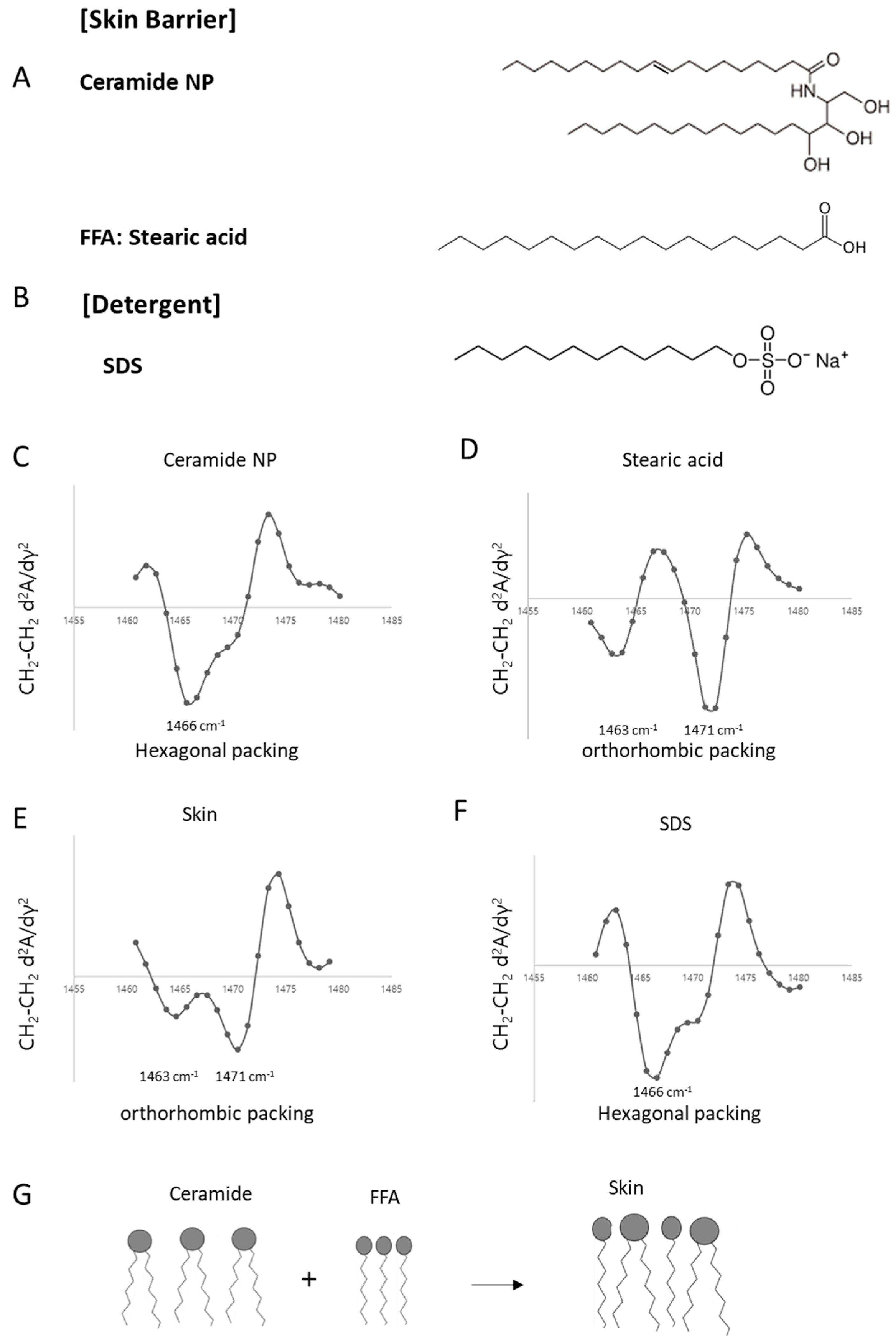

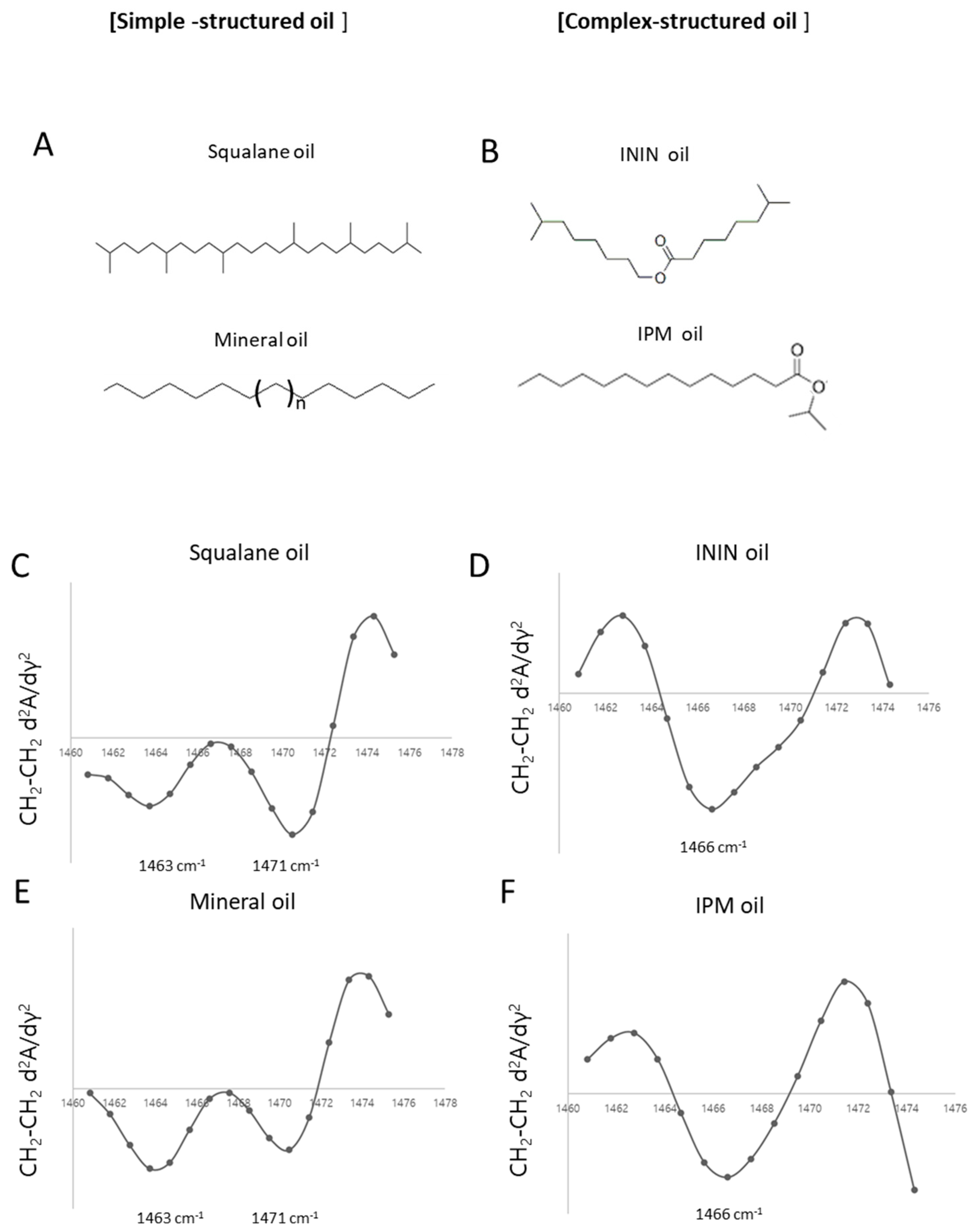

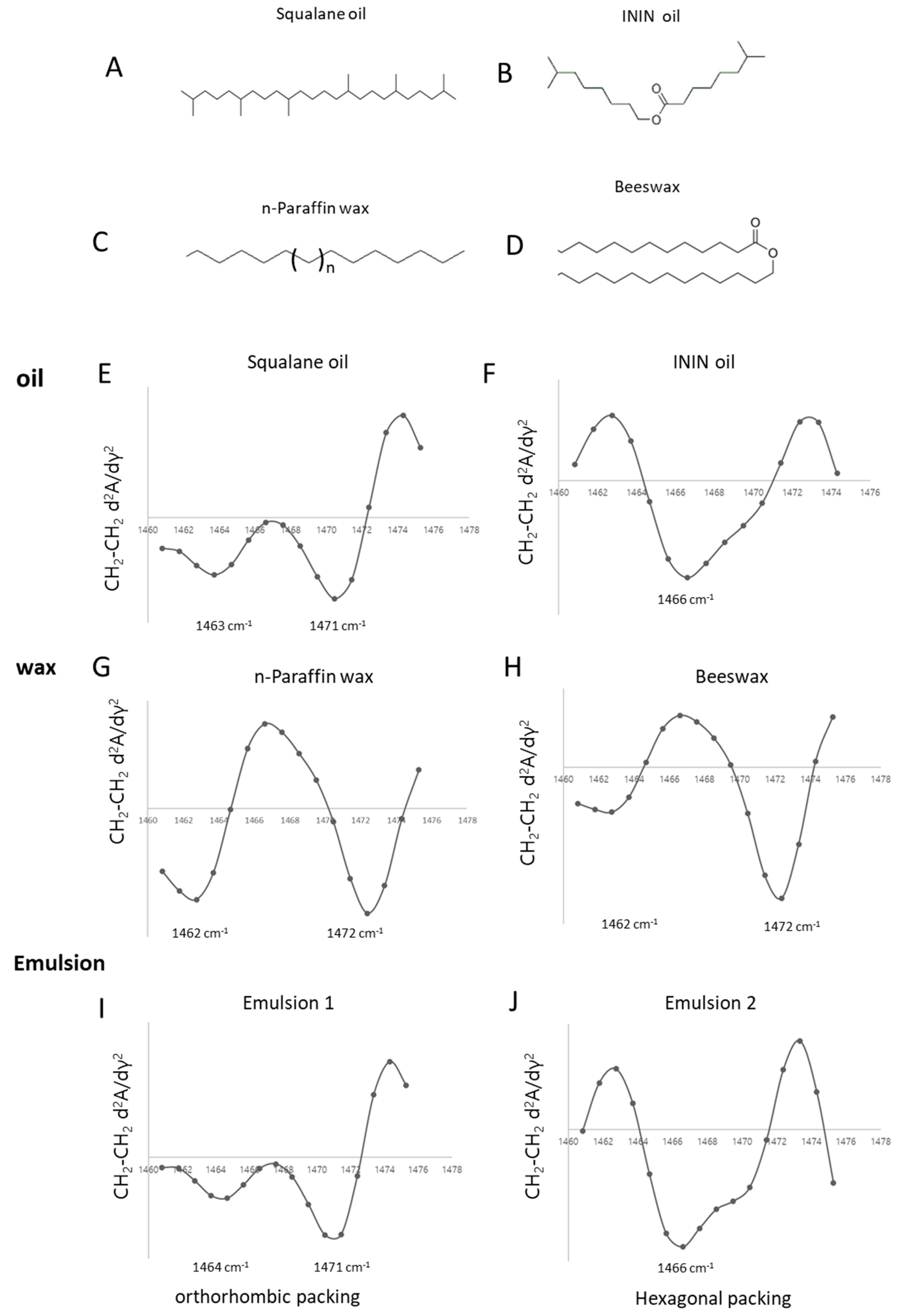
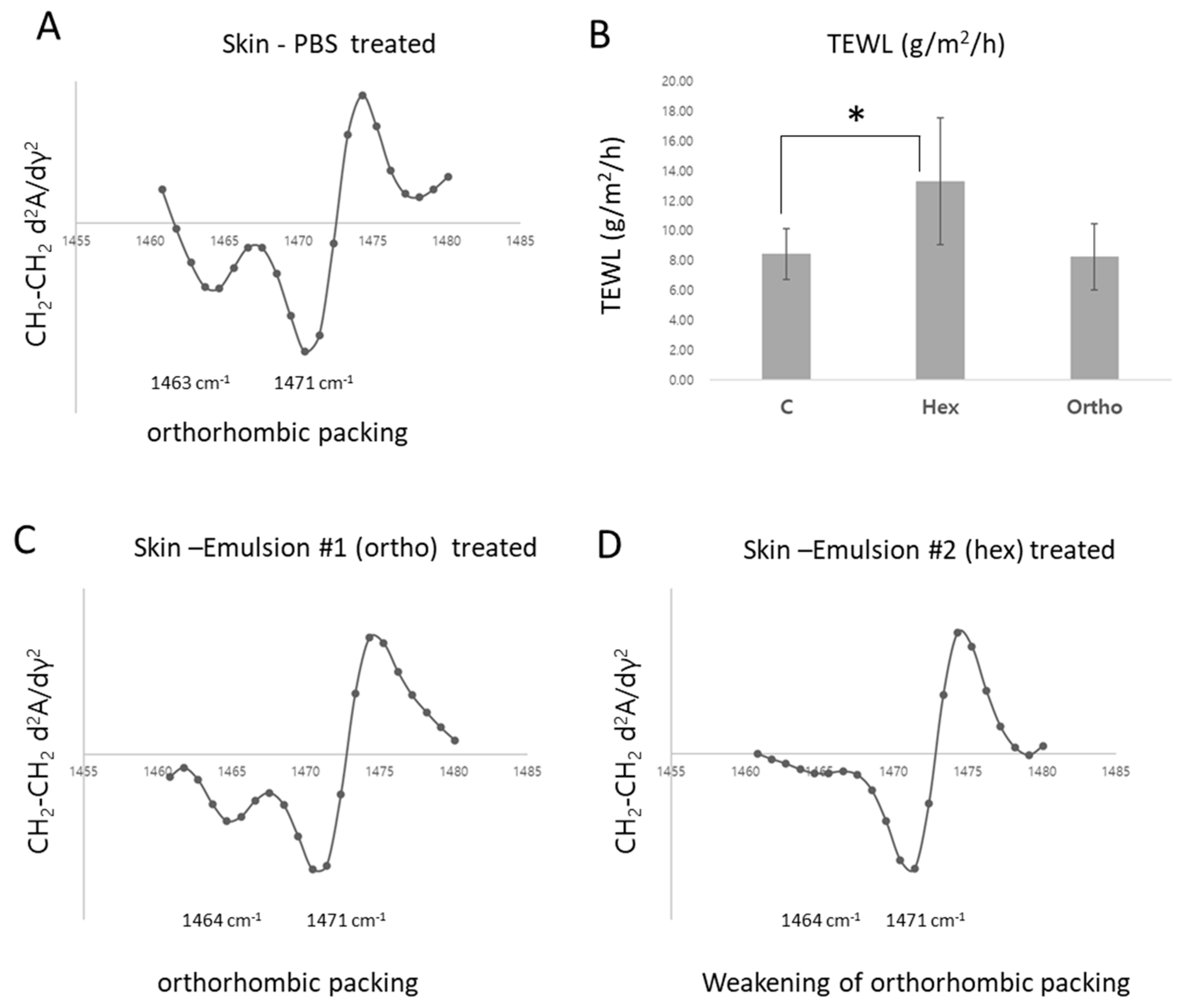

| Phase | Material | Emulsion 1 | Emulsion 2 |
|---|---|---|---|
| Water Phase | Water | 69% | 69% |
| 1,2-Hexanediol | 2% | 2% | |
| Glycerin | 5% | 5% | |
| Lipid Phase | Squalane | 16% | 0% |
| ININ | 0% | 16% | |
| n-Paraffin wax | 4% | 0% | |
| Beeswax | 0% | 4% | |
| Cetearyl Alcohol and Cetearyl Glucoside (Emulsifier) | 4% | 4% |
Disclaimer/Publisher’s Note: The statements, opinions and data contained in all publications are solely those of the individual author(s) and contributor(s) and not of MDPI and/or the editor(s). MDPI and/or the editor(s) disclaim responsibility for any injury to people or property resulting from any ideas, methods, instructions or products referred to in the content. |
© 2025 by the authors. Licensee MDPI, Basel, Switzerland. This article is an open access article distributed under the terms and conditions of the Creative Commons Attribution (CC BY) license (https://creativecommons.org/licenses/by/4.0/).
Share and Cite
Yun, Y.; Lee, S.-H. Orthorhombically Packed Cosmetic Oils or Formulations Could Ensure Skin Lipid Barrier Stability—An Ex Vivo Porcine Skin Study. Dermato 2025, 5, 20. https://doi.org/10.3390/dermato5040020
Yun Y, Lee S-H. Orthorhombically Packed Cosmetic Oils or Formulations Could Ensure Skin Lipid Barrier Stability—An Ex Vivo Porcine Skin Study. Dermato. 2025; 5(4):20. https://doi.org/10.3390/dermato5040020
Chicago/Turabian StyleYun, Yerin, and Seol-Hoon Lee. 2025. "Orthorhombically Packed Cosmetic Oils or Formulations Could Ensure Skin Lipid Barrier Stability—An Ex Vivo Porcine Skin Study" Dermato 5, no. 4: 20. https://doi.org/10.3390/dermato5040020
APA StyleYun, Y., & Lee, S.-H. (2025). Orthorhombically Packed Cosmetic Oils or Formulations Could Ensure Skin Lipid Barrier Stability—An Ex Vivo Porcine Skin Study. Dermato, 5(4), 20. https://doi.org/10.3390/dermato5040020






